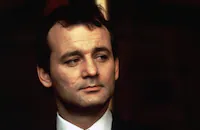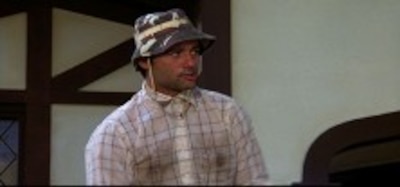Caddyshack
Brief Synopsis
Cast & Crew
Harold Ramis
Chevy Chase
Rodney Dangerfield
Michael O'keefe
Bill Murray
Paige Coffman
Film Details
Technical Specs
Synopsis
The Bushwood Country Club is home to all sorts of antics, from its gopher-obsessed groundskeeper Murray to its upwardly mobile caddies. When Rodney Dangerfield comes to town with designs on turning the golf course into condo units, vulgarity, battle of wills and assorted hijinks ensue.
Cast

Chevy Chase
Rodney Dangerfield
Michael O'keefe

Bill Murray
Paige Coffman

Albert Salmi
Mark Chiriboga
Scott Sudden
Lois Kibbee
Minerva Scelza
Violet Ramis
Patricia Wilcox
Dr Dow
Elaine Aiken
Kenneth Burritt
Thomas Carlin
Anna Uppstrom
Frank Schuller
Dennis Mccormack
Brian Doyle-murray
Rebecca Burritt
Mel Pape
Debi Frank
Lori Lowe
Judy Arman
Scott Jackson
James Hotchkiss
Scott Powell

Henry Wilcoxon
Tony Gulliver
Brian Mcconnachie
Donna M Wiggin
Chuck Rodent
Peter Berkrot
Marge Mckenna
Fred Buch
Dan Resin
Bobbie Kosstrin
Ann Crilley
Bruce Mclaughlin
Scott Colomby
Ted Knight
Jackie Davis
Sarah Holcomb
Marcus Breece
Cordis Heard
Cindy Morgan
Ron Frank
John F Barmon
Ann Ryerson
Kim Bordeaux
Hamilton Mitchell
Crew
Trevor Albert
Oscar Barber
Robert Barrere
Sam Berstein
Mary Lou Bird
David Bretherton
Melissa Bretherton
Donald C Carlson
William Carr
William Carruth
Vivian Cocheo
Eddie Cochran
Matthew Cokee
Tom Coll
Paul Collins
Michael Dilbeck
Brian Doyle-murray
John Dykstra
Michael Evje
Jonathan Fairbanks
D G Fisher
Stanley E Gilbert
Rocco Gioffre
Larry E Goodwin
Rachel Igel
Don K Ivey
Diane Johnson
Jack Johnson
Stan Jolley
Douglas Kenney
Douglas Kenney
Edward Knott
Elizabeth Lambert
Stevan Larner
Stevan Larner
Andre Lavery
Kenny Loggins
Kenny Loggins
Kenny Loggins
Don Macdonald
Calvin Maehl
Johnny Mandel
John Mcgowan
Michael P. Mcgowan
Hilly Michaels
Hilly Michaels
Bob Minkler
Susan Montgomery
Diane Morrison
Wallis Nicita
James Pergola
Dan Perri
Steve Perry
Charles Persons
Jon Peters
Marian Polan
Susana Preston
Harold Ramis
Hillary Anne Ripps
Hank Scelza
Neal Schon
Eric Seelig
Bill Smalling
Clive Smith
Mimi Stacey
William Swan
Ted Swanson
George Szeptycki
Peter Tors
Dick Tyler Sr.
Morgan Walker
Ray West
Steve Wever
David Whorf
Dean E Williams
Dee Dee Winner
John Louis Winner
Videos
Movie Clip




Trailer
Film Details
Technical Specs
Articles
Caddyshack
According to Ramis, Caddyshack was initially intended to be the story of a group of caddies, but as big names were hired onto the picture, the caddy characters, with the exception of Danny Noonan (Michael O'Keefe) took a backseat. But Ramis also says that at the time, he had in mind a dark comedy about the American Nazi party and Kenney wanted to do a film set in the Himalayas about Tibetan Buddhists fighting the red Chinese - so what can you believe? Though the latter might explain the confusion that production manager Mark Canton felt when the writers came in with a 199-page script. "I had no idea what it was," he admits.
Ramis feels that ultimately the picture is about caddy Danny Noonan's search for a role model. Not an easy search, considering his options. There's Ty Webb (Chevy Chase), the self-involved playboy golfer; stuffy club president Judge Smails (Ted Knight), uncle of clubhouse pin-up Lacey Underall (Cindy Morgan); and the degenerate rabble of the caddy shack. All Danny really wants is a way to earn money to get to college, but that task is complicated by the conflicting advice of those around him. Meanwhile, there's Carl the groundskeeper (Bill Murray) and his zealous hunt of the Bushwood gopher, and boorish new member Al Czervik (Rodney Dangerfield) who wants to turn the exclusive course into a condo development, plus a host of other characters and subplots to add to the chaos.
Co-writer Brian Doyle-Murray, who also appears as caddy master Lou Loomis, drew from his and his siblings' real-life experience as caddies: "A country club isn't just a place to take a ten-mile hike, whacking a ball at a small hole. It's its own subculture," he observes. Just like in Danny Noonan's family, there were nine young Murrays and several did a turn at caddying at the Indian Hill Country Club, outside Chicago. "Bill was a groundskeeper at another local course, the Evanston Country Club, which was the inspiration for his part in the picture," his brother says.
Whatever the original script looked like, the consensus is that very little of it turned up on the screen. Large portions of the film were ad-libbed, in true Second City and Saturday Night Live style. "It's an actual technique," Ramis explains. "Like having a script without finished dialogue." Some of the film's best moments occurred like this - "The Cinderella Story" speech by Murray, for example. In fact, Carl the groundskeeper was not a very large role in the film originally, but Murray (who Ramis first met when the actor was working the concession stand on an Illinois course) was on such a roll, that the filmmakers kept the camera rolling and kept getting gold. Anecdotes about his real-life involvement with golf as well as Caddyshack tidbits are found in Murray's book, Cinderella Story: My Life in Golf.
The film was set in Illinois, but shooting there would prove difficult as production began in late fall, along with the area's first snow. So producers headed to Florida to try and find a course minus the visual giveaways of palm trees and flamingos. Rolling Hills fit the bill, created by golf course architect William Mitchell, who was bored with the sub-tropic flora found throughout the state. Instead, he planted oaks and pines. Upon arriving at the location, Ted Knight remarked, "Gee it's so pretty. Too bad we have to destroy it." Though the producers did some construction on the clubhouse to create a mini studio, the worst that happened to the greens occurred during a famed night-time golf cart battle in which the cast and crew sought to recreate Patton and Rommel's African encounter. Neither carts nor course were reportedly recognizable the next day. The Boca Raton Hotel and Club was the setting for the dinner dance sequence.
Caddyshack was the first film that Ramis directed (several accounts have him looking through the wrong end of the camera on the first day of shooting) and the first major film appearance for Rodney Dangerfield. Both seemed to have had beginner's luck, though Dangerfield's minimal exposure to the film process did throw him for a loop initially. Scott Colomby (caddy Tony D'Annunzio), recalls that on Dangerfield's first day, the entire cast had assembled to watch the work of a comedy legend. But after a few takes, Dangerfield was sweating and looking distressed. When Colomby asked the veteran comic what was wrong, he said, "Nobody's laughing at me. I'm bombing out there! The comic was put at ease when Colomby explained that no one could laugh without ruining the take.
Mention must be made of the character that in some respects steals the show - namely, the gopher. The filmmakers auditioned live versions of every small mammal they could think of for the part, but to no avail. Finally it was decided that the gopher deserved special effects to make it work properly and the filmmakers went to John Dykstra of Industrial Light and Magic (ILM) fame.
Producer: Douglas Kenney, Donald MacDonald, Jon Peters
Director: Harold Ramis
Screenplay: Brian Doyle-Murray, Harold Ramis, Douglas Kenney
Cinematography: Stevan Larner
Film Editing: Robert Barrere, William Carruth, Rachel Igel
Art Direction: George Szeptycki
Music: Johnny Mandel, Kenny Loggins, Neal Schon
Cast: Chevy Chase (Ty Webb), Rodney Dangerfield (Al Czervik), Bill Murray (Carl Spackler), Michael O'Keefe (Danny Noonan), Ted Knight (Judge Smails), Sarah Holcomb (Maggie O'Hooligan).
C-99m. Letterboxed.
by Emily Soares

Caddyshack
Quotes
Trivia
Miscellaneous Notes
Released in United States June 1999
Released in United States Summer July 25, 1980
Shown at Newport International Film Festival (Bill Murray Retrospective) June 1-6, 1999.
Released in USA on video.
Released in United States June 1999 (Shown at Newport International Film Festival (Bill Murray Retrospective) June 1-6, 1999.)
Released in United States Summer July 25, 1980















